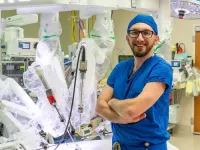(Press-News.org) Polar bear fur’s natural ability to resist ice formation could pave the way for safer, more sustainable solutions to prevent ice buildup across industries such as aviation and renewable energy, according to researchers at the University of Surrey.
An international study published in Science Advances has explored the anti-icing properties of polar bear fur in extreme Arctic conditions, revealing a unique mix of lipids in the fur’s sebum – an oily substance produced by the skin - that drastically reduces ice adhesion. In the face of climate change, this natural design could help prevent ice buildup on infrastructure such as frozen wind turbine blades or aeroplane wings.
Key to this discovery are the advanced quantum chemical simulations carried out by the University of Surrey’s computational chemistry team, which investigated molecular interactions between the fur’s sebum and ice.
Dr Marco Sacchi, Associate Professor at Surrey’s School of Chemistry and Chemical Engineering, is co-author of the study who led the group:
“We found that specific lipids in the sebum, such as cholesterol and diacylglycerols, exhibit very low adsorption energies on ice. This weak interaction is what prevents ice from adhering to the fur.”
Experiments confirmed these theoretical findings, measuring ice adhesion strength before and after the fur’s natural oils were removed. Researchers found that untreated polar bear fur performed on par with high-performance fluorocarbon coatings used in sports and industry. However, when it was washed to remove the sebum, ice adhesion was four times higher than unwashed samples.
The study also explored the fur’s hydrophobicity – its water-repelling properties – and how it delays the onset of freezing in the harsh Arctic, where temperatures drop below -40°C. Yet these properties alone could not explain the superior anti-icing performance.
Using techniques such as gas chromatography-mass spectrometry (GC-MS), liquid chromatography-mass spectrometry (LC-MS/MS), and nuclear magnetic resonance (NMR), the team found it was a unique mix of lipids – particularly an abundance of cholesterol and diacylglycerols – responsible for this ability.
Commenting on the revelation, Dr Sacchi said:
“It’s fascinating to see how evolution has optimised the sebum’s composition to avoid ice adhesion. We found squalene, a common lipid in other marine mammals, was almost entirely absent in polar bear fur. Our computational simulations revealed squalene strongly adheres to ice, and this absence significantly enhances the fur’s ice-shedding properties.”
Led by the Norwegian Polar Institute and the University of Bergen – with contributions from Trinity College Dublin, University College London, and the National Museum of Denmark – the research also highlights the importance of Indigenous knowledge of the Arctic and builds on that. Inuit communities have long recognised the unique properties of polar bear fur, using it in tools and garments.
Dr Sacchi added:
“Our findings highlight the power of interdisciplinary collaboration. We combined experimental evidence, computational chemistry and Indigenous Arctic insights to uncover a fascinating natural defence mechanism – which could transform how we combat ice in everything from aviation to renewable energy.”
Dr Sacchi’s computational team at Surrey included Dr Neubi F. Xavier Jr. and Adam Pestana Motala, who carried out the molecular modelling that underpins the study’s conclusions.
[ENDS]
Notes to editors
Dr Marco Sacchi is available for interview; please contact mediarelations@surrey.ac.uk to arrange.
The full paper is available at https://www.science.org/doi/10.1126/sciadv.ads7321
END
Scientists unlock ice-repelling secrets of polar bear fur for sustainable anti-freezing solutions
2025-01-31
ELSE PRESS RELEASES FROM THIS DATE:
Ear muscle we thought humans didn’t use — except for wiggling our ears — actually activates when people listen hard
2025-01-31
If you can wiggle your ears, you can use muscles that helped our distant ancestors listen closely. These auricular muscles helped change the shape of the pinna, or the shell of the ear, funneling sound to the eardrums. Millions of years ago, our ancestors stopped using them, so humans’ auricular muscles are only vestigial. But now scientists examining the function of these muscles have discovered that they activate when we’re trying to listen to competing sounds.
“There are three large muscles which connect the auricle to the skull and scalp and are important for ear ...
COVID-19 pandemic drove significant rise in patients choosing to leave ERs before medically recommended
2025-01-31
Researchers have long known that patients who leave emergency departments before medically advised use more emergency care services, are more likely to be readmitted to the hospital and face higher costs of care—as well as increased mortality rates.
Until now, however, little has been known about national, multi-year trends, including the impact of the COVID-19 pandemic on this phenomenon.
“In addition, most studies have focused on specific subgroups of patients, such as those with stroke or those with appendicitis who leave after surgery,” said Elena Andreyeva, PhD, a faculty member with the Texas A&M University School of Public ...
Burn grasslands to maintain them: What is good for biodiversity?
2025-01-31
As grasslands get abandoned, controlled burning is discussed as a labor-saving method of keeping forests at bay. A Kobe University research team found that this method results in higher biodiversity and a higher prevalence of endangered plant species in some grasslands compared to others, depending on what soils they grow on.
Humans have been keeping grasslands since millennia by grazing, mowing and controlled burning, all of these are means to keep forests from overgrowing the grasslands. Grazing and mowing are, however, labor intensive and as rural areas become increasingly depopulated, grasslands have been disappearing worldwide. One consequence ...
Ventilation in hospitals could cause viruses to spread further
2025-01-31
Increased use of ventilation and air cleaners, designed to mitigate the spread of viral infections in hospitals, is likely to have unpredictable effects and may cause viral particles to move around more, according to a new study from researchers at UCL and UCLH.
In the study, published in Aerosol Science & Technology, researchers investigated the effect of using built-in mechanical ventilation and portable air cleaners (PACs)1 upon the spread of airborne particles, which are similar to those breathed ...
New study finds high concentrations of plastics in the placentae of infants born prematurely
2025-01-30
UNDER EMBARGO UNTIL: Jan. 30, 2025, 3:30 p.m. MST
Media Contact: Karen Addis, APR, karen@addispr.com, +1 (301) 787-2394
Denver, Colo. ― Microplastics, which are less than 5 millimeters, and nanoplastics, which are invisible to the naked eye, are widespread throughout our environment. Research has shown that exposure to plastics in general is harmful to both the environment and humans.
Now, in a new study to be presented today at the Society for Maternal-Fetal Medicine’s (SMFM) annual meeting, The Pregnancy Meeting™, researchers will unveil findings that suggest that microplastics and nanoplastics have been found ...
New robotic surgical systems revolutionizing patient care
2025-01-30
SALT LAKE CITY— Huntsman Cancer Institute at the University of Utah (the U) proudly announces the addition of two da Vinci 5 robotic surgical systems. This state-of-the-art technology is designed to enhance precision, control, and safety during minimally invasive surgeries, setting a new standard in patient care. These advancements align with Huntsman Cancer Institute’s focus on successfully delivering world-class cancer care through innovative treatments.
“This is a significant leap forward in robotic surgery,” says Brian Mitzman, MD, MS, FACS, FCCP, Huntsman ...
New MSK research a step toward off-the-shelf CAR T cell therapy for cancer
2025-01-30
CAR T cell therapy is one of the most promising new cancer treatments to emerge in recent years. It involves removing a patient’s own immune T cells and engineering them to recognize specific targets on the surface of the cancer cell.
A major limitation of this type of CAR T cell therapy, called autologous therapy, is that the cells are taken from the patient and must be custom-made into a treatment. This requires patients to wait until their cells are modified for infusion — precious time they may not have.
Now research done at Memorial Sloan ...
UTEP professor wins prestigious research award from American Psychological Association
2025-01-30
EL PASO, Texas (Jan. 30, 2025) – Health sciences researcher Emre Umucu, Ph.D., associate professor and associate dean for research at The University of Texas at El Paso, has been awarded the Roger G. Barker Distinguished Research Contribution Award from the American Psychological Association (APA). The award honors research in the field of rehabilitation psychology, which focuses on helping individuals with disabilities and chronic conditions improve their health, independence and social participation.
“I am ...
New national study finds homicide and suicide is the #1 cause of maternal death in the U.S.
2025-01-30
UNDER EMBARGO UNTIL: Jan. 30, 2025, 2:45 p.m. MST
Media Contact: Karen Addis, APR, karen@addispr.com, +1 (301) 787-2394
Denver, Colo. -- In the medical community, research has traditionally focused on how to prevent and treat the leading medical causes of maternal mortality, which include bleeding, infection, hypertension, and cardiovascular disease. However, new research reveals deaths by homicide and suicide are the leading causes of maternal death in the United States.
In a study to be presented today at the Society for Maternal-Fetal ...
Women’s pelvic tissue tears during childbirth unstudied, until now
2025-01-30
Millions of women undergo episiotomies during childbirth every year, yet the mechanics behind these surgical cuts remain largely unstudied. A new research project is poised to change that, addressing this significant gap in women’s health.
An episiotomy involves cutting the pelvic-floor muscles to aid delivery, a technique currently guided largely by a surgeon’s personal judgment and experience. While intended to prevent severe vaginal tears or other complications during delivery, the procedure itself can lead to lasting pain, incontinence, infection, ...



